Walker Multi Anvil Apparatus
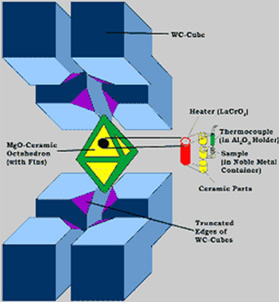
Multi-anvil systems can achieve pressures of 250 kbar andtemperatures to 3000℃. The sample is placed in a hole (purple coloredarea figure A) within a pressure medium shaped into an octahedron andfabricated from alumina, pyrophyllite or some other ceramic material, as shownin the opened view to the left. The faces of the octahedron seat against thetruncated corners (orange colored area figure A) of eighttungsten carbide (WC) cubic anvils. The cubes in turn are nested withinsplit-spherical or cylindrical seats fabricated from tool steel and sectionedinto segments that fit into a massively supported guide-block. Until recently,these systems were heavy and cumbersome, requiring very large presses and aconsiderable effort to operate them up to their design pressures.
The main obstacles to research on bulk materials at pressuresof 50-250 kbar have been eliminated as a result of simplifications tomulti-anvil design and technique recently introduced by Dr. David Walker at theLamont-Doherty Earth Observatory of Columbia University. As illustrated in theschematic cross-section below, and in the photographs of the Walker module, acylindrical cluster of wedges is used to seat the tungsten carbide anvils (C).The wedges are loose and free to float within their supporting ring. Massivesupport of the cluster is not used; rather, the elastic strain during loading istaken up directly by the supporting ring.
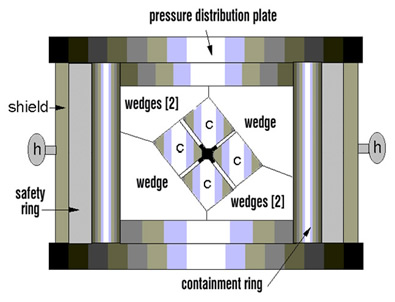
The mainobstacles to research on bulk materials at pressures of 50-250 kbar have beeneliminated as a result of simplifications to multi-anvil design and techniquerecently introduced by Dr. David Walker at the Lamont-Doherty Earth Observatoryof Columbia University. As illustrated in the schematic cross-section below,and in the photographs of the Walker module, a cylindrical cluster of wedges isused to seat the tungsten carbide anvils (C). The wedges are loose and free tofloat within their supporting ring. Massive support of the cluster is not used;rather, the elastic strain during loading is taken up directly by thesupporting ring.
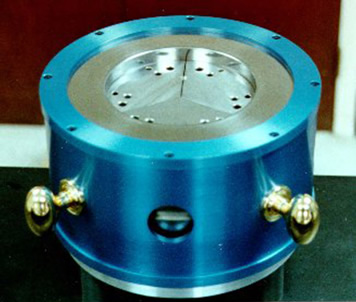
Module with upperpressure plate removed, showing the top cluster of three cylindrical wedgesinstalled over the WC cubes. Knobs mounted on outer shield permit easymaneuvering for positioning of the module in the press. Port between knobsprovides access for strain gauges.
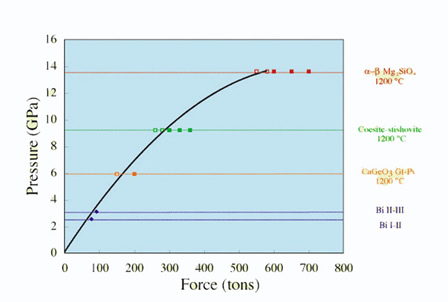
This graph shows the pressure calibration forthe 14/8 (ram force vs. the pressure of "fixed" transitions). The Walker module is used for achieving pressures up to 25 GPa. In this device,six anvil "wedges" press on 8 cubes which in turn press on anoctahedra press medium. The press is calibrated using a variety of sampleassemblies, using both castable ceramic and semi-sintered ceramic pressuremedia. This configuration is used at Dr. Paul Asimow's lab atCalTech. The 14/8 ass'y is configured as follows:
14 mm edge lengthoctahedron made of semi-sintered MgO plus 5 wt% Cr2O3
Stepped LaCrO3heater
Pyrophyllitegaskets with a cross section of 2.8 x 4.5 mm
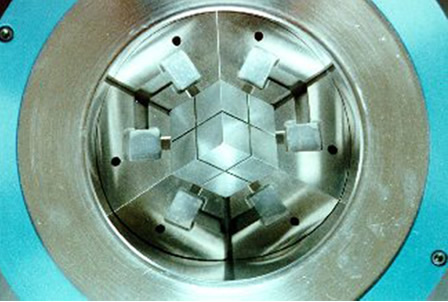
Walker modulewith view of (1") tungsten carbide anvils positioned on the lower set ofwedges. As shown in Figure A, the sample octahedron sits at the center ofsymmetry of the cubes
. 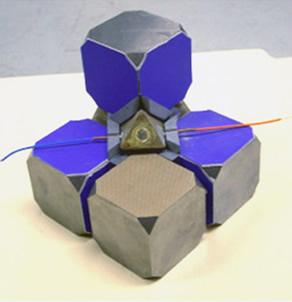
8 WalkerMulti-Anvil cubes compress the octahedron sample. Gaskets are made of Pyrophyllite.








